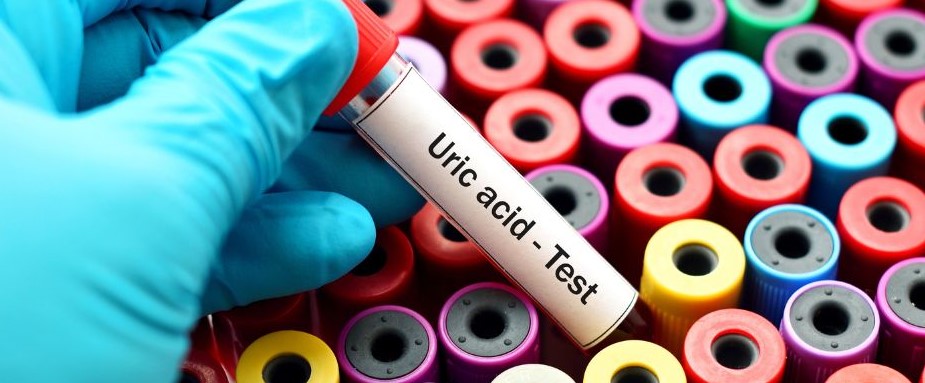Elevated uric acid levels have been classically associated with gout. However, emerging research over the past few decades has shown a causative association between any elevation in uric acid levels and the pathogenesis of cardiometabolic disease.
In February 2022, Dr. David Perlmutter published his book, Drop Acid, on the cardiometabolic and neurological consequences of elevated uric acid levels. The release of Drop Acid with its significant compilation of cited research articles brought elevated uric acid to the forefront of functional medicine as a highly modifiable risk factor.
The following sections detail the risks associated with elevated uric acid, how to evaluate this marker in your patients, and interventions that will help your patients optimize their uric acid levels.
Elevated Uric Acid: A Critical Warning Sign
Hyperuricemia is associated with the development of hypertension, metabolic syndrome, diabetes, non-alcoholic fatty liver disease and kidney disease.1 There are different mechanisms by which high uric acid can promote the development of these conditions. A common contributory mechanism is the stimulation of the nuclear factor kappa B (NF-κB) inflammatory pathway that raises IL-6 and measurable inflammatory biomarkers like CRP, fibrinogen and ferritin.2
Uric Acid, Hypertension and Cardiovascular Disease
There are two direct and two indirect mechanisms by which elevated uric acid contributes to the development of hypertension. High uric acid directly stimulates the renin-angiotensin system, causing increased sodium reabsorption in the kidneys and a consequential increase in blood volume and systemic blood pressure.3 Nitric oxide acts as a primary vasodilator to control blood flow through arteries. High uric acid strongly inhibits the activity and synthesis of nitric oxide, resulting in vasoconstriction and elevated arterial blood pressure.4
Elevated uric acid can indirectly raise blood pressure as well. The inflammatory and oxidative response of elevated uric acid directly damages the endothelial glycocalyx within the vascular lumen.5 The damage to the glycocalyx and delicate endothelium below causes excessive vascular permeability or “leaky vessels,” similar to how increased intestinal permeability is colloquially called “leaky gut.” “Leaky vessels” create the conditions for atherogenic molecules, such as oxLDL, LPS and other antigens, to enter the endothelium and begin the plaquing process. Plaquing narrows the vascular lumen, which increases intravascular pressure and, consequently, systemic pressure.
Finally, the inflammatory and microvascular changes damage the delicate glomeruli of the kidney. As the primary organ of uric acid excretion, damage to the kidney not only increases blood pressure but also causes elevations in uric acid. This then compounds systemic and vascular inflammation.6
Uric Acid, Fructose and Metabolic Syndrome
Fructose consumption in processed foods and sugar sweetened beverages has increased exponentially over the last few decades. Increased fructose consumption is thought to be the primary cause of metabolic syndrome, which has also risen exponentially in incidence.7 Because fructose is catabolized into uric acid, it may come as no surprise that increased fructose consumption in the general population has elevated uric acid levels as well.8
Furthermore, fructose is processed in the liver. Fructose catabolism stimulates lipogenesis of triglycerides. High triglycerides increase serum cholesterol and lipid congestion within the liver. Lipid congestion creates the conditions for insulin resistance and non-alcoholic fatty liver disease. Insulin resistance in the liver and the periphery tissue is also aggravated by endothelial dysfunction5 and oxidative stress.2 Untreated insulin resistance leads to pre-diabetes and diabetes.
Elevated uric acid can also stimulate weight gain by several mechanisms. High uric acid stimulates the enzyme adenosine monophosphate deaminase 2 (AMPD2), which activates fat storage in the liver and adipose tissue.9
High uric acid also inhibits the activity of the “fullness hormone” leptin, which can lead to overeating. Similarly, it disrupts dopamine signaling, leading to compulsive eating or food addiction, both of which can further increase the risk of obesity.11 Metabolic syndrome is so strongly associated with high uric acid levels that hyperuricemia is being considered a new diagnostic criterion for metabolic syndrome.5
Uric Acid and Cognitive Decline
Hyperuricemia is considered an independent risk factor for the development of cognitive impairment.12 The arterial plaquing mentioned earlier also occurs in the cerebral vessels, which can lead to the development of vascular dementia.13 Vasoconstriction from blocked nitric oxide production and activity impairs adequate blood flow and synaptic neuronal transmission.4 Even high-normal uric acid levels are thought to cause barely detectable mini strokes that would contribute to grey cell death and mental decline in aging adults.14
Patient Evaluation and Testing
This alarm bell for most patients is “silent” because they will have no symptoms of hyperuricemia until it gets to a level that produces obvious signs, like gout.
Check uric acid levels on patients with the following conditions:
- Hypertension
- Obesity
- Kidney disease (GFR <60 mL/min/1.73 m2)
- Dyslipidemia (especially high triglycerides or low HDL)
- Diabetes/pre-diabetes
- Non-alcoholic fatty liver disease
- Cognitive decline
- Thyroid disease
- Psoriasis
- High lead levels
Unlike other biomarkers, uric acid does not have standardized reference ranges (e.g., LDL cholesterol, HbA1c, etc.); therefore, there are disparities in reference ranges between lab companies. Since a functional medicine approach seeks to have optimal levels, we can utilize current research findings until the growing volume of supporting research requires the adoption of a standardized range.
A Japanese cohort study found that the lowest risk of developing cardiometabolic disease was at a uric acid level of less than 5 mg/dL in men and less than 4 mg/dL in women.10 These levels are vastly different from the reference ranges given on lab reports, which can be as high as 8.4 mg/dL. Interestingly, those ranges are present because they represent the median 95% of all samples collected. While it is understandable that they need to provide reference ranges when there is no standard range, assuming that 95% of the American population is metabolically “normal” is a significant misstep.

Lifestyle and Dietary Interventions
Lifestyle and dietary changes are always the primary approach for addressing any health condition. There are many interventions available to help your patients optimize their uric acid levels and support their long-term cardiometabolic health.
Diet and lifestyle
- Drink more than half the body weight in ounces of water each day to support uric acid excretion.
- Exercise
- Begin exercise slowly for inactive patients. Even once a week to start is a victory over their current sedentary lifestyles.
- The goal would be to work up to 150 minutes of exercise per week (e.g., walking, exercise bike, swimming or your patient's preference).
- Minimize or eliminate consumption of the following:
| High-Purine Foods | High-Fructose Foods and Drinks |
|---|---|
| Organ meats: liver, kidney, sweetbreads | Soda |
| Sardines | Juice |
| Anchovies | Candy |
| Shrimp | Ice cream, popsicles |
| Halibut | Packaged cookies, cupcakes, pastries, crackers |
| Crab | Sauces, dressings |
| Tuna | Jams, jellies |
| Brewer’s yeast/beer | Honey |
Targeted nutrients
The following targeted nutrients are also recommended for optimizing uric acid levels:
| Nutrient | Dose | Action |
|---|---|---|
| Vitamin C | 500 mg/day | · Enhances uric acid excretion from the kidneys · Antioxidant and anti-inflammatory activity · Co-factor for collagen synthesis for tissue repair |
| Quercetin | 250-500 mg/day | · Strongly inhibits xanthine oxidase activity · Antioxidant and anti-inflammatory activity · Inhibits advanced glycation end products · Lowers LDL-C levels |
| Luteolin | 100 mg/day | · Strongly inhibits xanthine oxidase activity · Neuroprotective · Antioxidant and anti-inflammatory activity |
| Tart cherry powder | 200-400 mg/day | · Inhibits adenosine deaminase (upstream of xanthine oxidase) · Strong antioxidant and anti-inflammatory activity |
| Berberine | 1,000-2,000 mg/day | · Activates AMPK to promote weight loss · Improves insulin sensitivity · Reduces LDL-C and triglycerides levels |
| Fish oil | 1,000-2,000mg/day | · Lowers blood pressure · Improves cholesterol levels · Neuroprotective · Anti-inflammatory |
The Bottom Line
Hopefully, this entry has provided you with helpful insights into the diverse cardiometabolic dangers of high uric acid levels. Testing for uric acid is no longer included in routine bloodwork despite its significance. Functional medicine providers must continue to sound the alarm and encourage others to also investigate and treat elevated uric acid with confidence.

Megan Borreson, ND is the CM Vitals Clinical Brand Manager at Lifestyle Matrix Resource Center. She attended undergraduate school at the University of Wisconsin–Eau Claire and received her Bachelor of Science degree in cell biology and a Bachelor of Arts degree in Spanish with a minor in chemistry. Dr. Borreson then enrolled at National University of Health Sciences where she graduated summa cum laude with a Master of Acupuncture and Doctorate of Naturopathic Medicine.
References
- Kanbay M, Jensen T, Solak Y, et al. Uric acid in metabolic syndrome: From an innocent bystander to a central player. Eur J Intern Med. 2016;29:3-8. doi:10.1016/j.ejim.2015.11.026
- Spiga R, Marini MA, Mancuso E, et al. Uric Acid Is Associated With Inflammatory Biomarkers and Induces Inflammation Via Activating the NF-κB Signaling Pathway in HepG2 Cells. Arterioscler Thromb Vasc Biol. 2017;37(6):1241-1249. doi:10.1161/ATVBAHA.117.309128
- Chaudhary K, Malhotra K, Sowers J, Aroor A. Uric Acid - key ingredient in the recipe for cardiorenal metabolic syndrome. Cardiorenal Med. 2013;3(3):208-220. doi:10.1159/000355405
- Stephan BC, Wells JC, Brayne C, Albanese E, Siervo M. Increased fructose intake as a risk factor for dementia. J Gerontol A Biol Sci Med Sci. 2010;65(8):809-814. doi:10.1093/gerona/glq079
- Bahadoran Z, Mirmiran P, Kashfi K, Ghasemi A. Hyperuricemia-induced endothelial insulin resistance: the nitric oxide connection. Pflugers Arch. 2022;474(1):83-98. doi:10.1007/s00424-021-02606-2
- Álvarez-Lario B, Macarrón-Vicente J. Uric acid and evolution. Rheumatology (Oxford). 2010;49(11):2010-2015. doi:10.1093/rheumatology/keq204
- Hosseini-Esfahani F, Bahadoran Z, Mirmiran P, Hosseinpour-Niazi S, Hosseinpanah F, Azizi F. Dietary fructose and risk of metabolic syndrome in adults: Tehran Lipid and Glucose study. Nutr Metab (Lond). 2011;8(1):50. Published 2011 Jul 12. doi:10.1186/1743-7075-8-50
- Russo E, Leoncini G, Esposito P, Garibotto G, Pontremoli R, Viazzi F. Fructose and Uric Acid: Major Mediators of Cardiovascular Disease Risk Starting at Pediatric Age. Int J Mol Sci. 2020;21(12):4479. Published 2020 Jun 24. doi:10.3390/ijms21124479
- Lanaspa MA, Epperson LE, Li N, et al. Opposing activity changes in AMP deaminase and AMP-activated protein kinase in the hibernating ground squirrel. PLoS One. 2015;10(4):e0123509. Published 2015 Apr 9.
- Kuwabara M, Hisatome I, Niwa K, et al. The Optimal Range of Serum Uric Acid for Cardiometabolic Diseases: A 5-Year Japanese Cohort Study. J Clin Med. 2020;9(4):942. Published 2020 Mar 30. doi:10.3390/jcm9040942
- Meyers AM, Mourra D, Beeler JA. High fructose corn syrup induces metabolic dysregulation and altered dopamine signaling in the absence of obesity. PLoS One. 2017;12(12):e0190206. Published 2017 Dec 29. doi:10.1371/journal.pone.0190206
- Suzuki K, Koide D, Fujii K, Yamazaki T, Tsuji S, Iwata A. Elevated Serum Uric Acid Levels Are Related to Cognitive Deterioration in an Elderly Japanese Population. Dement Geriatr Cogn Dis Extra. 2016;6(3):580-588. Published 2016 Dec 22. doi:10.1159/000454660
- Euser SM, Hofman A, Westendorp RG, Breteler MM. Serum uric acid and cognitive function and dementia. Brain. 2009;132(Pt 2):377-382. doi:10.1093/brain/awn316
- Mini-strokes linked to uric acid levels. ScienceDaily. https://www.sciencedaily.com/releases/2007/10/071001172809.htm. Published October 5, 2007. Accessed January 25, 2023.



